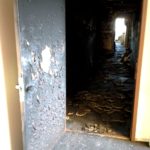This week marks the 100th anniversary of Fire Prevention Week, which commemorates the Great Chicago Fire. This devastating fire, which began on October 8, 1871, killed more than 250 people, left 100,000 homeless, destroyed more than 17,400 structures, and burned more than 2,000 acres of land. The National Fire Protection Association (NFPA) has many great resources available for Fire Prevention Week, as well as a post on the NFPA blog, and a video about the Great Chicago Fire.
As we have seen demonstrated in fires throughout history, fire door assemblies play a very important role in a building’s passive fire protection system. The correct specification, installation, and maintenance of these opening protectives can mean the difference between life and death for building occupants. However, many existing fire doors have deficiencies that could affect their performance during a fire – missing or damaged components, auxiliary hardware used to prop doors open, or creative methods to prevent the hardware from latching.
Code-compliant fire door assemblies deter the spread of smoke, flames, and toxic gases during a fire, compartmentalizing the building and protecting the means of egress to allow building occupants to escape. This week I will be sharing some of the resources available on iDigHardware related to fire door assemblies, to increase awareness of the requirements of the codes and standards that help to ensure fire doors perform as designed and tested.
The posts for this week will focus on the four main steps when specifying or selecting door hardware: (1) hang the door, (2) secure the door, (3) control the door and (4) protect the door. But before we get into the details, today’s resources provide an overview of fire doors and fire door inspection:
- Anatomy of a Fire Door (video) – Learn the basics of fire door assemblies and fire door inspection by watching this whiteboard animation video.
- Laminated Fire Door Inspection Card – This card detailing NFPA 80’s requirements for fire door inspection was recently updated and is available on the Fire Door page.
- Construction Specifier – Fire Door Safety: How can specifiers help? – This recent article includes tips for specifiers that will help keep fire doors functioning properly over the life of the building.
- Decoded: The importance of fire doors in residential occupancies – A tragic fire in the Bronx exposed the risks of open fire doors, and this Decoded article explains the importance of residential fire door assemblies.
- Allegion Code Reference Guide – Download this free 40-page guide or request hard copies; the current edition of the guide includes updates from the 2021 model codes.
- Decoded Course – The second class in this on-demand series covers the requirements for fire door assemblies – there are additional classes in this course that focus on accessibility, life safety and egress, and electrified hardware.
Check back tomorrow for more about fire doors, and follow along on Allegion US for social updates and resources:
You need to login or register to bookmark/favorite this content.














Leave A Comment